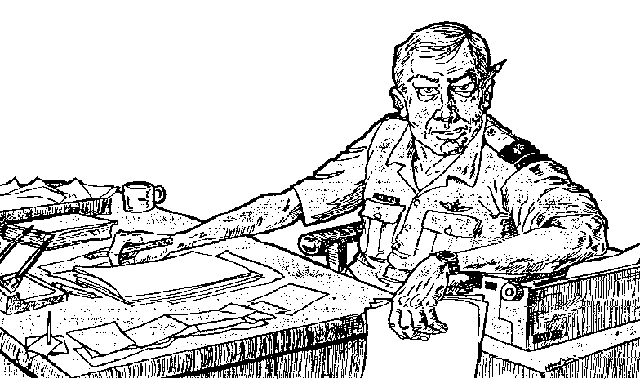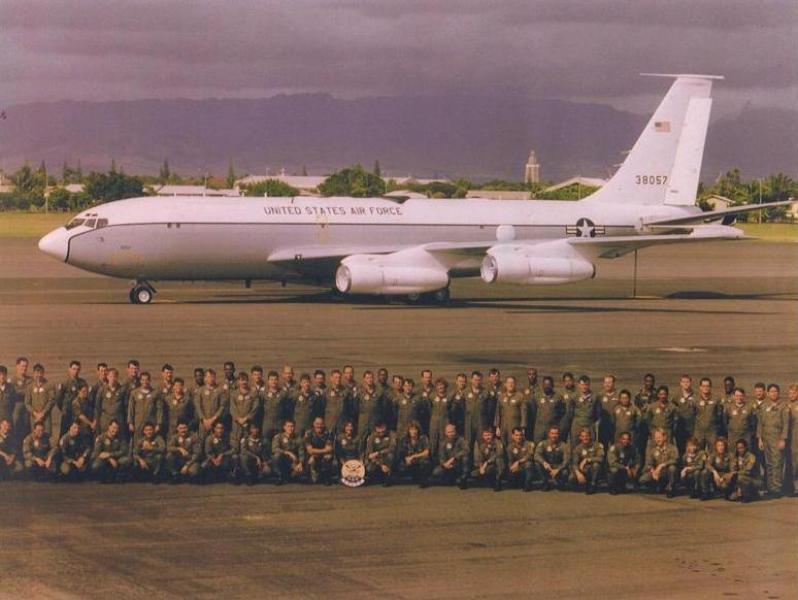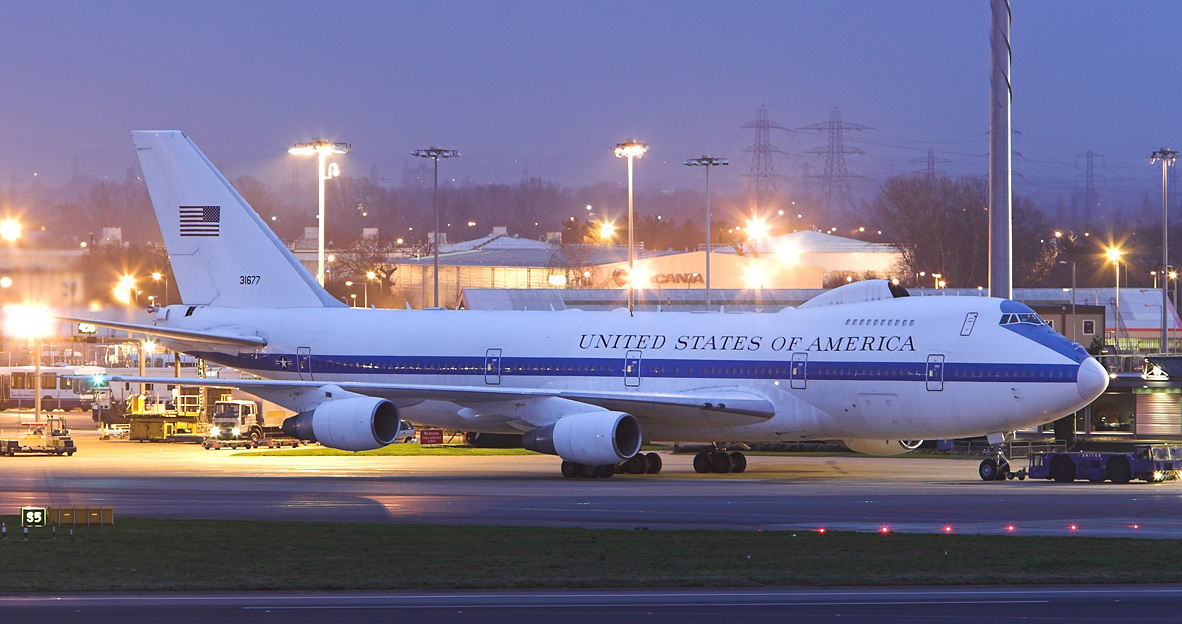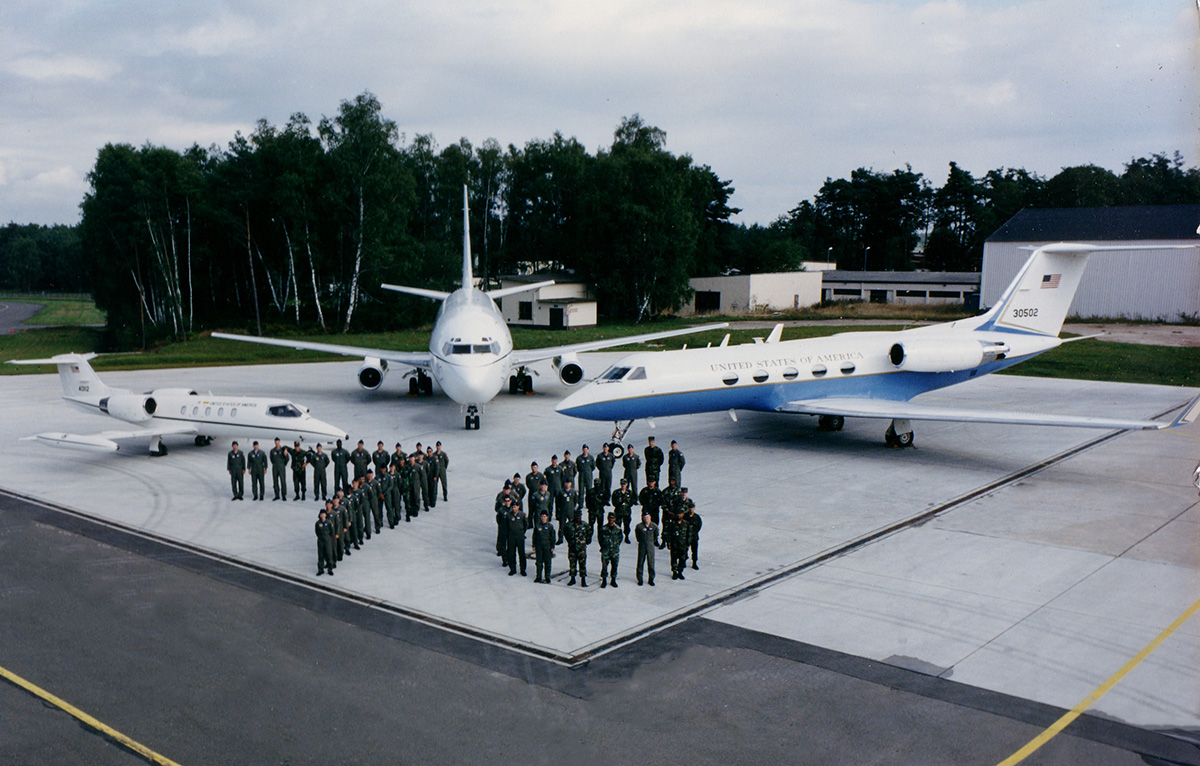"The Rules" are twenty-six ideas I've collected over the years that seemed relevant enough to life in general that I've written each down with a short story to reinforce each in particular. This is Rule Number Twenty-Four.
— James Albright

Updated:
2012-06-01
Every now and then I get a request from a younger pilot asking, "How do you lead a flight department?" Well that's a complicated question isn't it? Whenever I get a compliment about my leadership style my answer is usually, "I learned from the worst." Glibness aside, what follows is something I wrote during my last job in the Air Force, leading a legislative liaison office with several pilots aspiring to be squadron commanders. I think its lessons apply to leading a civilian flight department.
One of my favorite techniques as the guy in charge of a flight department, squadron, or even an office staff is what I like to call “leadership by conspicuous example.” I grew up believing the conventional wisdom; leading by example would fulfill what my Japanese mother would say I needed the most: humble correctness.
Humble or not, leadership by example only gets noticed by those who least need the example. If you want to impact the behavior of a large group of subordinates, peers, or even superiors, you have to make sure the lesson cannot be missed. My okasan would not approve. But the technique has worked for me.
Oh yes, if you are looking for a course on leadership, here it is: Leadership.

Lead by conspicuous example
1994
Leadership by (Conspicuous) Example (1994)
When I joined the Air Force Boeing 707 squadron in Hawaii, most the pilots were professional aviators in every sense: great stick-and-rudder pilots, aircraft systems experts, and they knew international operations in the Pacific backwards and forwards. When everyone was a part of the A-team, everyone did whatever it took to keep up with the pack. Each pilot took pride in smoothly flying the 300,000 pound airplane as if it were a nimble glider. When the inevitable mechanical system hiccuped, they knew what to do before the first checklist was opened; and they had the discipline to open the checklist anyway. Wherever the schedule took us, they knew and flew foreign country procedures without fail. They set a very high bar for us copilots.
Sadly, most those guys left very soon after my arrival. The airlines were hiring, the Air Force was forcing older pilots out of the cockpit, and we soon found ourselves going from one of the most senior squadrons in the Air Force to a very run of the mill outfit.
When the few of us copilots indoctrinated by the A-team became aircraft commanders and instructor pilots, we yearned to bring back the professionalism of days past. We started our own cadre of systems experts and pilots extraordinaire. We would know every nut and bolt on our aircraft. We would be able to fly to the lowest minimums in the worst weather and not break a sweat. We studied everything and held study sessions to reinforce everything we learned. Our training missions started with clear objectives and ended with brutal critiques. As the commander of crew five, I was content knowing my crew was shooting for those bygone heights.
A few years later I wound up as the squadron’s chief of standardization and evaluation, the lead flight examiner. Now I would be seeing firsthand how all seven crews were doing. They were not doing well. Fully half the crews didn’t know their systems well enough to deal with anything but routine operations. Instrument skills were lax. The bad check rides were piling up: everything from turning the wrong way in a holding pattern to leaving the gear up for landing. Our small group of leaders were only having an impact on ourselves: we were preaching to the choir. Those who needed the leadership were ignoring it. I found I had very little impact until I ended up in their jumps seat and had to tap them on the shoulder, “captain, extend the landing gear and make this a full stop.”
Leadership by Executive Fiat
Years later, in another squadron, I was flying a routine mission from Point A to Point B when the lead passenger came to the cockpit with a message from his boss. “I need to get to the base no later than noon, can you make that happen?”
“I’ll do my best.” My best, in the Boeing 747, meant flying at 0.92 Mach. The engineers call this VMO, the maximum operating velocity. We didn’t do this often because it used a lot more gas and the rush of the air over the 747 hump turned our normally quiet cabin into something more like a 707. We preferred 0.86 Mach, where we had the best trade off between fuel and speed but there was no prohibition against flying at VMO. I got the passengers to Point B on time and they sent a letter to my squadron commander in thanks.
“Haskel! Get in here.” The squadron was packed with people when the call over the public address system crackled. Everyone recognized the squadron commander’s squealing voice and everyone knew I was in trouble. I walked into Lieutenant Colonel Rodney P. Larson's office and received the dressing down of my career, all for flying above 0.86 Mach. He marched me out of his office to the squadron ready room and addressed the crowd of pilots, navigators, and flight engineers. “The next pilot that flies the airplane above eight six Mach is fired!”
We all took note and for the next two months we started missing arrival block times. With each week came another complaint from the Pentagon about our once stellar block time performance going south. Finally the White House itself complained and there were more public beheadings. The following week Lieutenant Colonel Larson was in the pilot’s seat when it became apparent to all he needed more speed. Quietly, and without ceremony, he nudged the throttles forward and the Mach meter crept towards 0.90. The ban on Mach was ended. Even the emperor, it would seem, couldn’t live with his own edicts.
Leadership by Conspicuous Example
By the year 1994, when I took command of the 76th Airlift Squadron, I had been an Air Force officer a total of fourteen years and had attended three formal leadership schools: Squadron Officer’s School, Air Command and Staff College, and the Air Force Squadron Commander’s Course. None of them prepared me as well as the examples I had been given by the ten squadron commanders in the four flying squadrons I had served.
When I showed up at Ramstein Air Base, Germany, my boss handed me an envelope with instructions to read and then destroy. My predecessor had been hounded out of command by thirteen inspector general complaints accusing him of everything from illegal use of government property to sexual harassment. Thirteen members of the 120 person squadron filed formal charges. By that yardstick, at least ten percent of his people hated him.
One of the complaints was about the squadron commander reserving the best trips for himself, those flying to ideal European locations, and consigning everything else to everyone else. A quick glance at the end of year report showed the best trips went to the most senior pilots, he being the most senior. His operations officer, by contrast, had very little flying time since one of the two had to be at home at all times. If the commander was away, the ops officer was grounded.
“Hey boss,” the ops officer knocked on my door, “we got a Gulfstream trip to Istres, you want it?”
“That’s off Monaco, isn’t it?”
“Sure is,” he said with a wide grin, “beautiful, warm beaches, good food, the works.”
“You take it.”
“Really?”
“Sure.”
I went out of my way to fly every lousy weekend trip to every war torn country on the continent. At my staff meetings I made a special effort to trade war stories with my three flight commanders. Pretty soon they too were bragging about the latest shit hole they had seen. Not too long after that, I overheard line pilots asking their flight commanders to take a milk run or two, just out of fairness.
Not that every leadership story in a flying squadron involves flying. The best ones often don’t.
I was catching up on paperwork one Sunday afternoon, sitting in my office with an oblique view of the flight line. I heard a Gulfstream park, shut down, and the normal cacophony of the crews putting the airplane to bed. One-by-one the crew walked into the squadron, each stopping by to say hello. The pilot, copilot, flight engineer, and radio operator each paid their respects; but not the flight attendant. One of the inspector general complaints that sunk my predecessor was poor crew camaraderie and an “everyone out for themselves” mentality. I remember reading a letter from the previous commander admonishing his crews that the mission wasn’t done until the airplane was ready for its next trip, and nobody was done until everyone was done. Pretty soon returning crewmembers were exiting the squadron, on their way to the parking lot and home. But still no flight attendant.
I walked out to the Gulfstream and found the stairs still down and walked into the cabin and turned right. There was the flight attendant, Shelly, washing dishes.
“Need a hand?”
“No, sir,” she said, “it took me some extra time to vacuum the cabin. These senators were real slobs.” She laughed nervously.
“Nobody else knows how to use a vacuum?”
More nervous laughter. I picked up a dish towel and started drying and putting away the dishes, or at least trying to. “Maybe I should wash,” I said, “since you know where everything goes.”
We spent the next few minutes chatting, washing, and drying. I heard a second Gulfstream come in and shut down. In another five there was a noisy entry as one of the new arrival’s pilots stormed in. “Where is that worthless captain . . .” He stopped in his tracks as I looked forward, soapy dish in hand.
“Oh sorry, sir,” he said, “I thought it was Fred flying this trip.”
“It was,” I said, “but I guess Fred was too busy to help his flight attendant clean up so I thought I would.”
The youngster excused himself and I saw him dart across to his Gulfstream. Shelly and I finished our chores and closed the airplane. She thanked me and I excused myself to have a chat with mechanics in a nearby hangar. As I walked away I overheard the second Gulfstream’s flight attendant greet Shelly, “guess who I got washing dishes!”
“No,” Shelly said, “you guess who I had washing dishes first!”
I like to think my twenty minutes washing dishes did more good than any letter, commander’s call, or public beheadings could have possibly accomplished. I’ll never know, of course.



